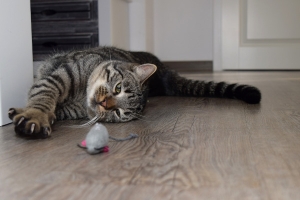Should NH ban cat declawing?

Anyone who has ever owned a cat knows they can be moody creatures—accepting a gentle pat one minute, thrashing their claws at you the next. To avoid this, some cat owners take their cats to the vet to have their claws removed, but animal rights advocates deeply oppose this practice. This year, the Legislature will consider HB 1226, which would ban cat declawing. The surgery would become a misdemeanor; there would, however, be an exception to the ban if there was a medical reason for declawing the cat.
How does it work?
While declawing may sound like a relatively straight forward procedure to remove a cat’s nails, it isn’t quite that simple. Instead, veterinarians must amputate the last bone on each toe. Usually, a scalpel or guillotine clipper is used to perform the operation, and then the wounds are closed with stiches or surgical glue. There is also a version of the surgery that uses laser technology to slice through the tissue.
There is another method of cat declawing called a tendonectomy. This involves severing the tendon that controls the claw in each toe. The result is that cats can’t extend their claws to scratch. Cats that have undergone tendonectomies require more frequent nail trimmings, since they can’t maintain them by scratching.
Arguments for and against declawing
Cats instinctively keep their nails in check by scratching—in a home, this can mean damaging furniture or even scratching people. The latter can be especially dangerous, since cat scratches can carry disease.
Sometimes, owners feel declawing their cat is the best solution. This could especially be true if young children live in the household. Many would argue that it is often the only alternative to giving an overly-aggressive cat up for adoption.
Opponents, however, say that cat declawing is a cruel and unnecessary medical procedure. It prevents the cat from maintaining its nails. It also causes pain to the animal and may lead to infection, tissue necrosis, lameness, and more.
Ultimately, opponents argue it’s much better to train your cat to use a scratching post. There are also other non-surgical options, such as soft plastic cups that can be glued to the cats nails, or tape that can be stuck to furniture to deter scratching.
About HB 1226
HB 1226 prohibits the declawing of cats except when it is medically necessary. Medical reasons for declawing a cat could include existing or recurring illness, infection, disease, injury, or other abnormal condition in the claw that compromises the cat's health. The bill specifically forbids removing the claws of a cat for cosmetic reasons or to make keeping the cat more convenient for the owner. Violating the law would be a class B misdemeanor. To put that in perspective, first offense DWI, computer fraud, and theft of property valued at more than $500 but less than $1,000 are all class B misdemeanors.
This isn’t the first time a cat-declawing ban has been floated in the Legislature. In 2020 lawmakers considered HB 1387 to prohibit the procedure. The bill was defeated in a 198-157 vote.
Make your voice heard
What do you think? Should pet owners maintain the right to declaw their cats if they choose? Or, should the Granite State outlaw this surgery, except when it’s medically necessary for the cat? You can attend the public hearing for this bill and let lawmakers know where you stand. It will take place on January 25 at 3:00 p.m. in the Legislative Office Building, Room 301-303.
Update: The House voted to kill HB 1226 on February 16, 2022. Click here to explore the latest legislative proposals related to animal rights.











Comments
Login or register to post comments